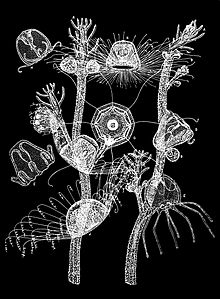Turritopsis
Appearance
| Turritopsis | |
|---|---|

| |
| Scientific classification | |
| Domain: | Eukaryota |
| Kingdom: | Animalia |
| Phylum: | Cnidaria |
| Class: | Hydrozoa |
| Order: | Anthoathecata |
| Family: | Oceaniidae |
| Genus: | Turritopsis McCrady, 1857[1] |
| Species | |
|
See text | |
| Synonyms | |
Turritopsis is a genus of hydrozoans in the family Oceaniidae.
Species
[edit]According to the World Register of Marine Species, this genus includes the following species:[2]
- Turritopsis chevalense (Thorneley, 1904) – species inquirenda
- Turritopsis dohrnii (Weismann, 1883) also known as the "Benjamin Button jellyfish", or the "immortal jellyfish". It can reverse its life cycle and transform itself back to a polyp.[3]
- Turritopsis fascicularis Fraser, 1943
- Turritopsis lata Lendenfeld, 1884
- Turritopsis minor (Nutting, 1905)
- Turritopsis nutricula McCrady, 1857 (several species, including the "immortal jellyfish", were formerly classified as T. nutricula)[4]
- Turritopsis pacifica Maas, 1909
- Turritopsis pleurostoma (Péron & Lesueur, 1809) – species inquirenda
- Turritopsis polycirrha (Keferstein, 1862)
- Turritopsis rubra Farquhar, 1895
References
[edit]- ^ "Turritopsis". Integrated Taxonomic Information System. Retrieved 16 June 2011.
- ^ "Turritopsis". WoRMS. World Register of Marine Species. Retrieved 5 August 2012.
- ^ Nathaniel Rich (28 November 2012). "Can a Jellyfish Unlock the Secret of Immortality?". The New York Times. Retrieved 28 November 2012.
For this reason Turritopsis dohrnii is often referred to as the Benjamin Button jellyfish.
- ^ M. P. Miglietta; S. Piraino; S. Kubota; P. Schuchert (2007). "Species in the genus Turritopsis (Cnidaria, Hydrozoa): a molecular evaluation". Journal of Zoological Systematics and Evolutionary Research. 45 (1): 11–19. doi:10.1111/j.1439-0469.2006.00379.x.
- "Turritopsis". National Center for Biotechnology Information (NCBI).
- "Turritopsis" at the Encyclopedia of Life

